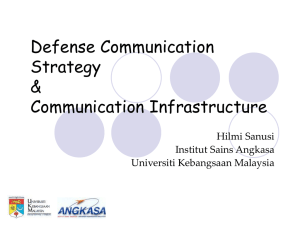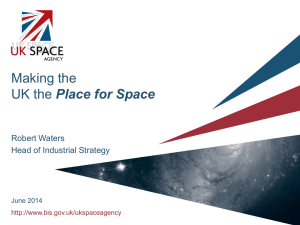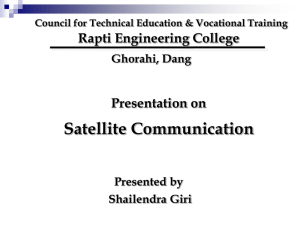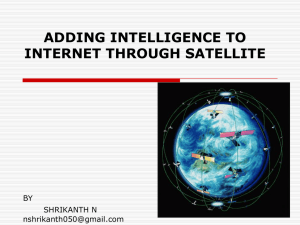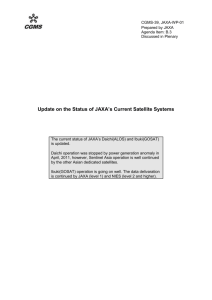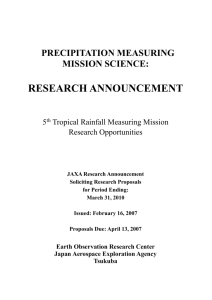Satellite Earth Observations and their Impact on Society and Policy
advertisement
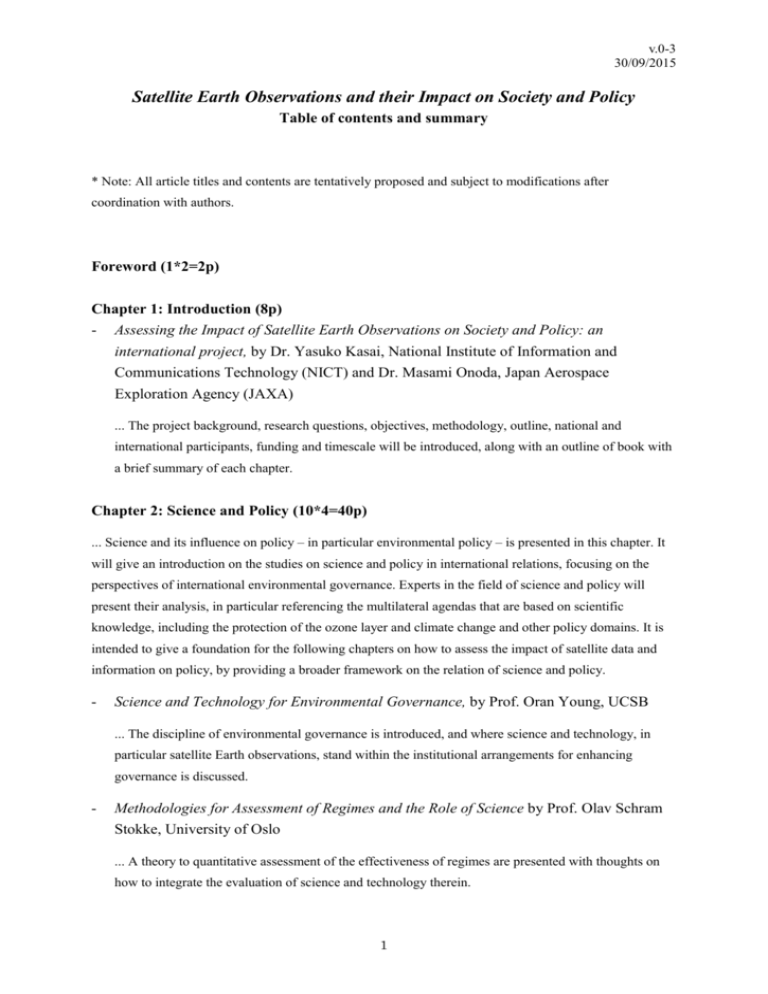
v.0-3 30/09/2015 Satellite Earth Observations and their Impact on Society and Policy Table of contents and summary * Note: All article titles and contents are tentatively proposed and subject to modifications after coordination with authors. Foreword (1*2=2p) Chapter 1: Introduction (8p) - Assessing the Impact of Satellite Earth Observations on Society and Policy: an international project, by Dr. Yasuko Kasai, National Institute of Information and Communications Technology (NICT) and Dr. Masami Onoda, Japan Aerospace Exploration Agency (JAXA) ... The project background, research questions, objectives, methodology, outline, national and international participants, funding and timescale will be introduced, along with an outline of book with a brief summary of each chapter. Chapter 2: Science and Policy (10*4=40p) ... Science and its influence on policy – in particular environmental policy – is presented in this chapter. It will give an introduction on the studies on science and policy in international relations, focusing on the perspectives of international environmental governance. Experts in the field of science and policy will present their analysis, in particular referencing the multilateral agendas that are based on scientific knowledge, including the protection of the ozone layer and climate change and other policy domains. It is intended to give a foundation for the following chapters on how to assess the impact of satellite data and information on policy, by providing a broader framework on the relation of science and policy. - Science and Technology for Environmental Governance, by Prof. Oran Young, UCSB ... The discipline of environmental governance is introduced, and where science and technology, in particular satellite Earth observations, stand within the institutional arrangements for enhancing governance is discussed. - Methodologies for Assessment of Regimes and the Role of Science by Prof. Olav Schram Stokke, University of Oslo ... A theory to quantitative assessment of the effectiveness of regimes are presented with thoughts on how to integrate the evaluation of science and technology therein. 1 v.0-3 30/09/2015 - Science and technology in Japanese Environmental Policy by Prof. Kazuo Matsushita, Kyoto University/Institute for Global Environmental Strategies (IGES) ... The Japanese perspectives will be given on the role of science and technology in the history and future Japanese environmental policy. - Science and the Climate Change Policy by Prof. Yasuko Kameyama, NIES (tbc) ... The impact of science in the climate change negotiations will be discussed, and the possibility of quantifiable evaluation will be explored. Chapter 3: Analytical framework (10p) - Applying the Studies on Science and Policy to Analyze the Role of Satellite Technology, by Prof. Oran Young, University of California Santa Barbara (UCSB) and Dr. Masami Onoda, JAXA ... The methodology of research will be discussed in more detail, including surveys on existing studies and an analysis of those studies, proposing a framework where possible models and recommendations can be built upon. Chapter 4: Policy and Earth Observation Innovation Cycle Project (10*6=60) ...The book will conclude by reviewing in this chapter the “Policy and Satellite Earth Observation Innovation Cycle (PEOIC)” project, which aims to objectively and quantitatively assess the impact of satellite observations on environmental policy and use this information to propose a mission that would achieve an “innovation cycle”, whereby the assessment would feed back to new innovation for next-generation observation technology, thus contributing to global policy demand. The ultimate goal beyond this project is to build a society where there is such a working cycle. The hypothesis of this study is that in order to make such a cycle work, there is a need to bridge the existing gap in the assessment of the effectiveness of satellite observations to feed back into the next satellite observation programmes. - Background and Outline of Project by Prof. Yasuko Kasai, NICT ... Based on Chapter 1 but in a more focused scope pertaining to this project, the background, research questions, objectives, methodology and framework will be introduced, with an introduction on each sub-chapters that will follow. - Analytical Framework for Assessment by Dr. Masami Onoda, JAXA ... This sub-chapter will build on the analytical framework proposed in Chapter 2 to describe how specifically this project has defined its scope and approach for the studies. It will introduce the literature survey, proposed case studies and how methodologies were identified in order to answer the 2 v.0-3 30/09/2015 question of how to perform an objective assessment of the impact of satellite Earth observation on policy, leading to the work presented in the following chapters. - Policy by Prof. Setsuko Aoki, Keio University and Prof. Akiko Okamatsu, Hosei University ... The outcomes of the review of archival records documenting the road leading to the Montreal Protocol for the protection of the ozone layer, and further on the UN Framework Convention on Climate Change will be highlighted in this sub-chapter. Also studies around the arctic policy and Earth observations will be introduced. - Data Mining by Prof. Akiko Aizawa, National Institute of Informatics ... This sub-chapter will describe the work done by the group to perform document analysis with the aim to explore possible linkages between Earth observation and policy from text collections such as scientific papers, newspaper articles, or official political documents. With proper assistance of human experts, natural language processing techniques are capable of providing a way to quantitatively verify the detected relationship across the different text collections. - Use of Earth observation data in the proposed UNFCCC REDD+ forest reference emission levels (FRELs) by Dr. Brian Johnson, Dr. Henry Scheyvens and Hiromitsu Samejima, IGES - [UNFCC, Kyoto Protocol, REDD+ and the Impact of Earth Observations ... to be integrated in Brian’s paper or to be included in Ake-san’s chapter] ... Focus on forest observations, which is the only example where satellite Earth observation data is starting to be operationally used for national reporting in global environmental regimes. - Possible Adaptation to a Satellite Mission by Dr. Yasuko Kasai, NICT ... A potential future satellite mission (or a model of such a mission concept) building on the outcomes of this project will be proposed. - Assessment Methodologies by Dr. Masami Onoda, JAXA ... The chapter will conclude by proposing options for methodologies for quantitative assessment of the impact of Earth observations to environmental policy. Chapter 5: Earth Observation for Society and Policy (10*10=100) ... In this chapter, experts are invited to contribute examples of how their agencies are responding to the needs of their country’s policy ambitions, as well as coordinated international policies in relation to climate and environment. Authors will present their work specifically related to space-based Earth observation and its socio-economic benefits; to assess the policy or science requirements for planning future satellite Earth observations; or to demonstrate the values and challenges of specific satellite missions to address policy requirements. 3 v.0-3 30/09/2015 - Addressing the Needs of Science and the Society by Satellite Earth Observation: The NASA Decadal Survey and other studies by Dr. Molly Macauley, Resources for the Future - Benefits Assessment of Applied Earth Science by Dr. Lawrence Friedl, NASA - Global Earth Observation System of Systems Benefits Studies by Dr. Michael Obsersteiner, International Institute for Applied Systems Analysis - Economic Values of Space: The experience of the OECD Space Forum by Claire Jolly, OECD - French Earth Observation Strategy by Dr. Murielle Lafaye, French Space Agency (CNES) - Atmospheric Observations for Public Health and its Impact to Society by Dr. Carlos Dora, World Health Organization - ESA Earth Observation Strategy by Dr. Josef Aschbacher, European Space Agency - Greenhouse Gases Observation from Space by Tatsuya Yokota, NIES - Global Forest Observations by Dr. Ake Rosenqvist, Solo EO - JAXA Earth Observation Strategy for the Future by Teruyuki Nakajima, JAXA (or Ichiro Naito, JAXA) - Chinese Earth Observation Programme and Policy by tbc, China (tbc) - The GEOSS new 10-year Strategy for 2016 and Beyond by Barbara Ryan, Group on Earth Observations (tbc) Chapter 6: The Impact of Innovation (10*3=30) ... Innovations from new entrants to the satellite Earth observation domain and their impact on societal policy will be examined in this chapter. These new players are not only disrupting the commercial Earth observation sector, but also providing new avenues and opportunities for Earth observation to impact society and policy. This chapter will collate inputs from some of the current leaders in Earth observation innovation to provide a glimpse of the potential future of satellite Earth observation and policy evolution. - Innovative Satellite Mission Planning for Societal Needs and the UK Earth Observation Policy by Sir Martin Sweeting, SSTL - The Open Data Innovation by Dr. Yuko Noguchi, Creative Commons (tbc) - The Google Earth Data Applications by tbc, Google - Game-changing Commercial Satellite Imagery by tbc, Skybox Imaging (tbc) 4 v.0-3 30/09/2015 - The Possibility to Use Big Data Analysis for Future Satellite Planning?? by tbc, Preferred Infrastructure (tbc) Chapter 7: Conclusion (5p) - Innovative Earth Observation for Society and Policy by Dr. Yasuko Kasai, NICT and Dr. Masami Onoda, JAXA ... This chapter will summarise all chapters, and conclude by integrating the inputs of international experts and the PEOIC project by identifying generic models, criteria or recommendations that might prompt organizations/agencies that are working on missions to consider the connection of science and technology to environmental policy. It is hoped that this will be an important addition to the existing studies on the socio-economic benefits of Earth observations by applying an institutional approach in order to bridge science and policy. - Glossary (5p) Total estimated: approx. 260p 5




